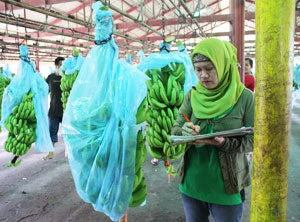 |
| Bananas for export go through rigorous quality inspection. The plantation employs some 2,000 workers in Maguindanao, Mindanao. |
“It was a war zone, one of the most dangerous places on earth.”
That’s how Mr. Resty Kamag, human resource manager of La Frutera plantation based in Datu Paglas (Population: 20,290) in Maguindanao (the Philippines) described the national road traversing the town from the adjacent province.
Residents and travelers, he said, wouldn’t dare pass through the highway after three in the afternoon for fear of getting robbed, ambushed or caught in the crossfire between rebels and government soldiers.
“That was before the company started operations here in 1997,” said Mr. Kamag. La Frutera operates a 1,200-hectare plantation for export bananas in Datu Paglas and neighboring towns, providing jobs to more than 2,000 people.
“Today, the town is peaceful,” he said. “Travelers now come and go without fear of getting harmed. People have better things to do.”
I was in Datu Paglas late January 2013 together with the World Bank’s social development team led by John Roome and Ousmane Dione. The trip to Datu Paglas was part of our itinerary after visiting some Bank-assisted projects in the Autonomous Region in Muslim Mindanao (ARMM) – particularly Maguindanao, Sultan Kudarat, and North Cotabato.
Twenty, thirty years ago, this story would have been unthinkable.
Way back in college, I remember passing through the provinces of Maguindanao and Sultan Kudarat, holding my breath, praying that no one started shooting. Checkpoints manned by armed men of nebulous identities and affiliations (rebels looked like government soldiers and some soldiers sported long hair like rebels) dotted the lonely highways. Along both sides of the dusty roads, wide swathes of tall cogon and sword grasses (talahib) with razor-sharp edges thrived on idle lands.
A joint project by foreign investors (Unifruitti group) and Filipinos including Toto Paglas, a charismatic Muslim leader, La Frutera spent millions building roads, bridges, irrigation systems and other facilities.
The company infuses the local economy with 11 million pesos of monthly payroll, encouraging local entrepreneurs to set up retail shops, banks and small businesses. Other companies like Del Monte followed suit establishing agribusiness plantations in other parts of the province.
Today, paved highways cut through thriving towns and fields planted to rice, corn, coconuts, palm oil, rubber trees, and bananas. If one wonders how lasting peace in Mindanao would look like should there be a final peace agreement after the signing of the Framework Agreement on the Bangsamoro (.pdf) in October 2012, it will probably be Datu Paglas and nearby towns, where people have opportunities for making a living and no longer fear the coming of the night.
Some people may wonder whether or not Muslims, indigenous peoples and Christians could work together in harmony. When I visited the town of Aleosan in North Cotabato – a melting pot of various religions (Muslims, Christians) and ethnicities (Cebuanos, Ilonggos, Maguindanaoans, Maranaos and Iranuns) – I saw all peoples making a strong effort to work together in peace.
Aleosan is implementing several projects under the World Bank-assisted Mindanao Rural Development Program, being managed by the Department of Agriculture (DA). The town’s mayor, Loreto Cabaya, said that many of the projects – farm-to-market roads, water systems and livelihoods – target conflict-affected barangays (villages) to help them recover fast while raising farm productivity.
An assessment by the DA showed that the projects under this program have raised farmers’ incomes by about 17 percent. “We used to transport our produce using carabaos (water buffalos) and horses because of bad roads. Now, because of better roads to the market, trucks and tractors could come up our place and we are able to deliver our produce (mostly corn, vegetables, copra, coffee, livestock and rubber) to buyers at the least cost,” said one farmer-leader.
“We are positioning Aleosan to be the leader in producing livestock and rubber in the region. The program has enhanced our capability to achieve this vision,” said Mayor Cabaya. “We are prepared for the influx of investments and jobs [that the peace agreement might bring as a peace dividend].”
In short, my take home message from that visit?
First, the Datu Paglas example tells us that, contrary to some perception, ARMM and conflict-affected areas in Mindanao, are capable of hosting investments that are beneficial to investors and local communities.
Second, Aleosan demonstrates that various peoples and from different cultural, ethnic and religious backgrounds could work together for the betterment of their communities, given adequate support from the national government and development partners.
And third, should a final peace deal between the government and the Moro Islamic Liberation Front be forged, there are good examples on how Mindanao could move faster towards prosperity that is shared by all.


Join the Conversation